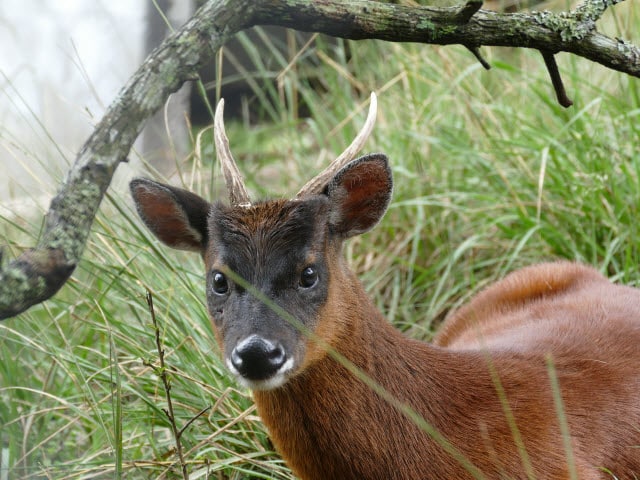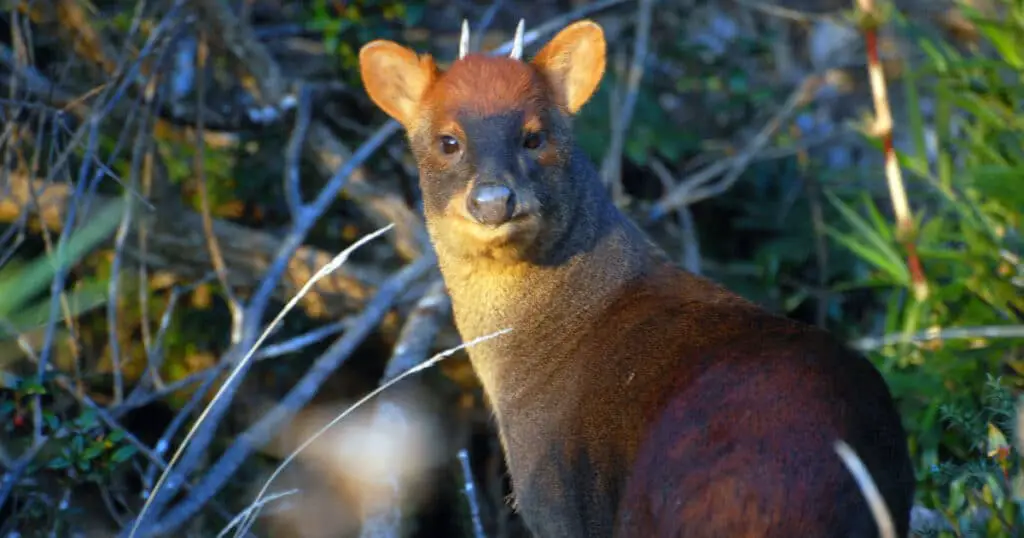The Northern Pudu (pudu mephistopheles) is the smallest type of deer in the world and typically weighs less than 13 pounds when mature.
Northern Pudu deer have a compact, rounded body and inhabit the Andes Mountains in Columbia, Ecuador, and Puru, prefering to live high above the sea level in a temperate rainforest where there is plenty of forage.
Northern Pudu Size
Table of Contents
Toggle| Head & Body Length | 60 – 80 cm |
| Shoulder Height | Up to 35 cm |
| Tail Length | 2 – 3 cm |
| Weight | 8 – 10 kilograms |
Learn More About the Northern Pudu (pudu mephistopheles)

Physical Appearance
The Northern Pudu is a small species of deer, only slightly larger than the Southern Pudu. It has a small rounded body, thin delicate legs, and short spike like antlers.
The coat is dark brown in color, and is thick and dense, offering good protection from the harsh elements of the habitat in which it lives.
The ears of pudu mephistopheles are small and rounded, and the tail is short. The pre-orbital glands are small.
The antlers are only short simple spikes.
There are two species of Pudu, the Northern one is smaller than the Southern species and it lives in different habitats than its southern counterpart.
Where Does the Northern Pudu Live?
This small deer lives in the South American countries of Ecuador and Peru where it is found on the Paramos and Punas regions. It has a more northerly distribution than the Southern Pudu.
Habitat of the Northern Pudu Deer
This small deer lives on high mountain slopes and steppe lands, mostly at altitudes of between 3,000 and 4,000 metres in height.
You’re unlikely to see one, and certainly you will not see the pudu mephistopheles at lower elevations (unlike the Southern Pudu). This pudu prefers open habitats without much cover. It prefers high grasslands and scrublands.
Breeding & Reproduction
Little is known about the reproductive life of this species. It is thought that the pudu mephistopheles males may be territorial, and mate with the females present within their territories.
After a 200 day long gestation period, normally a single young is born to the pudu mephistopheles. The fawn is un-spotted unlike the young of the Southern Pudu and many other deer.
Pudu young stay with their mother until they are about a year of age, when they become sexually mature.
Behavior
As of yet, little is known about the behavior and lifestyle of this animal.
The Northern Pudu is shy and secretive, and because of the difficult terrain in which it lives, research into it has been hindered and is extremely difficult.
This small deer appears to live either alone or in small pairings, in small territories.
Pudu Mephistopheles Diet
The Northern Pudu feeds mainly on grasses and herbaceous plants which it finds within the habitat in which it lives.




